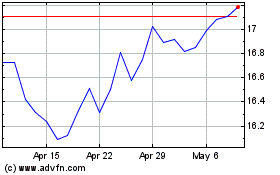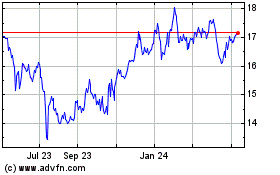By Akane Otani and Caitlin McCabe
Some big-name stocks are sporting chunky dividend yields. Many
yield-starved investors are still saying no thanks.
Companies in the S&P 500 with at least a quarter-century
record of paying out and increasing dividends -- dubbed "dividend
aristocrats" by Wall Street -- have trailed the broader stock
market this year. That is even as record-low interest rates have
resulted in a scarcity of yield across the world.
The S&P 500 Dividend Aristocrats Index, which measures the
performance of 65 companies, has fallen 0.7% this year, while the
broader S&P 500 has risen 7.3%. That puts the benchmark index
on pace to outperform the dividend aristocrats index by the widest
margin since 2007.
Meanwhile, some of the most iconic dividend aristocrats have
fared even worse.
Exxon Mobil Corp., whose dividend yield is sitting at a
near-record of more than 10%, has tumbled 51% in 2020, burned by a
collapse in oil prices. AT&T Inc., with a dividend yield of
more than 7%, has fallen 29% as the coronavirus pandemic has
weighed on the company's foray into show business. And Walgreens
Boots Alliance Inc., offering a nearly 5% dividend yield, has
plummeted 35% as fewer customers have trafficked its stores due to
Covid-19.
The slide in stock prices shows the extent to which many
investors are worried about the prospects for dividend aristocrats.
The index recently offered a dividend yield of about 2.7% -- humble
in nominal terms, but still greater than the S&P 500's dividend
yield of about 1.7% and more than triple the yield of the 10-year
U.S. Treasury note.
Even so, that hasn't been enough to persuade investors who have
yanked more than $40 billion from global dividend-focused mutual
and exchange-traded funds in 2020 through Wednesday, according to
data from EPFR. That surpasses the more than $3 billion that was
pulled during the same approximate period in 2019. With the new
coronavirus having upturned the economy, many investors have
instead sought returns from highflying tech stocks amid worries
that many of the long-established dividend payers aren't guaranteed
to deliver in the coming year.
"You had more volatility in the dividend space than you normally
do and I think that turned a lot of investors off," said Richard
Sherry, a portfolio manager at Kayne Anderson Rudnick.
Only one company, Ross Stores Inc., has been removed from the
dividend aristocrats index this year after suspending its dividend
payout, according to S&P Dow Jones Indices.
Still, a number of investors believe that, even among the
dividend aristocrats, there could be cuts on the horizon.
Mr. Sherry, who manages several funds that invest in value
stocks and companies with robust dividend yields, sold Exxon shares
earlier this year when he noticed the company's cash flow getting
worse and as the oil-price fight between Saudi Arabia and Russia
intensified. Exxon has had to take on debt to cover its hefty
payouts, raising questions about the sustainability of its dividend
strategy.
An Exxon spokesman said in an email that the company had a long
history of providing investors a reliable and growing dividend. "A
large portion of our shareholder base has come to view that
dividend as a source of stability in their income, and we take that
very seriously," he added.
Some investors say traders already are placing bets on a
potential dividend cut. Activity in the options market implies
Exxon's dividend will fall by more than half by this time next
year, said Michael Khouw, chief investment officer of Optimize
Advisors.
"With companies that have abnormally high dividends, something
is usually going to give, and more often than not it's the
dividend," Mr. Khouw said.
He added that Exxon rival Chevron Corp. also looks vulnerable
given its debt load and the sweeping challenges the energy industry
faces at the moment. Chevron didn't immediately respond to a
request for comment.
Other companies within the energy industry, including Royal
Dutch Shell PLC and BP PLC, have cut their dividends this year.
Neither company is in the dividend aristocrats index.
A dividend cut or suspension could ramp up selling pressure on
Exxon, said Bill McMahon, chief investment officer of active equity
strategies for Charles Schwab Investment Management.
"The thing that [Exxon] needs to weigh is that the people who
are invested in that stock are really there for the dividend," Mr.
McMahon said.
Some analysts are advising yield-seeking clients to focus more
on companies with stable balance sheets and a trend of dividend
increases, rather than the firms with the biggest overall dividend
yields. Bank stocks, for instance, have historically offered
investors relatively good yields. But the Federal Reserve has
warned that banks could face as much as $700 billion in loan losses
if the economic recovery takes longer than expected, making the
group a potentially risky play.
"The economic recovery is likely to be too slow to just dive in"
to even deeply discounted shares because of their dividend yields,
said Simeon Hyman, global investment strategist at ProShares.
Several dividend aristocrats have managed to outperform not just
the group but also the S&P 500 this year. Target Corp., which
has a dividend yield of 1.7%, is up 25% in the year to date. Lowe's
Cos., which has a dividend yield of nearly 1.4%, has risen 44%.
Stocks trading at higher prices typically offer lower dividend
yields, while those trading at lower prices tend to have higher
dividend yields.
Because bond yields have fallen so much in the past few years,
many companies already offer dividend yields that exceed those of
ultrasafe government bonds. At the close of trading Friday, about
70% of S&P 500 companies had dividend yields above the 10-year
Treasury yield, compared with nearly 48% at the end of last year,
according to Dow Jones Market Data. The yield on the 10-year
Treasury settled Friday at 0.840%.
Investors like Mr. Sherry believe that despite not faring well
this year, many dividend stocks will likely enjoy a resurgence in
popularity at some point. Clients he has spoken to have indicated
they still want a source of relatively stable income, especially
given how volatile the broader market has been this year.
"Given the low interest rates, investors will recognize a need
to look at dividend-paying stocks," he said, noting that many will
specifically be looking for "stocks that have come out the other
side of Covid-19 with strong balance sheets and cash flow. And
that's when these stocks will do better in the marketplace."
Write to Akane Otani at akane.otani@wsj.com and Caitlin McCabe
at caitlin.mccabe@wsj.com
(END) Dow Jones Newswires
October 25, 2020 05:44 ET (09:44 GMT)
Copyright (c) 2020 Dow Jones & Company, Inc.
AT&T (NYSE:T)
Historical Stock Chart
From Mar 2024 to Apr 2024

AT&T (NYSE:T)
Historical Stock Chart
From Apr 2023 to Apr 2024
